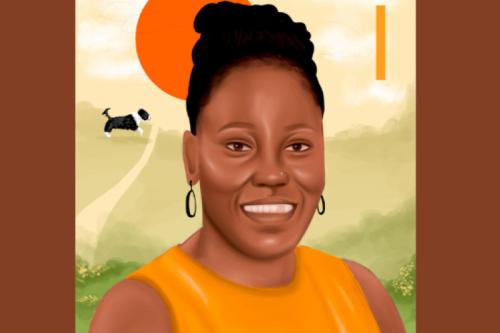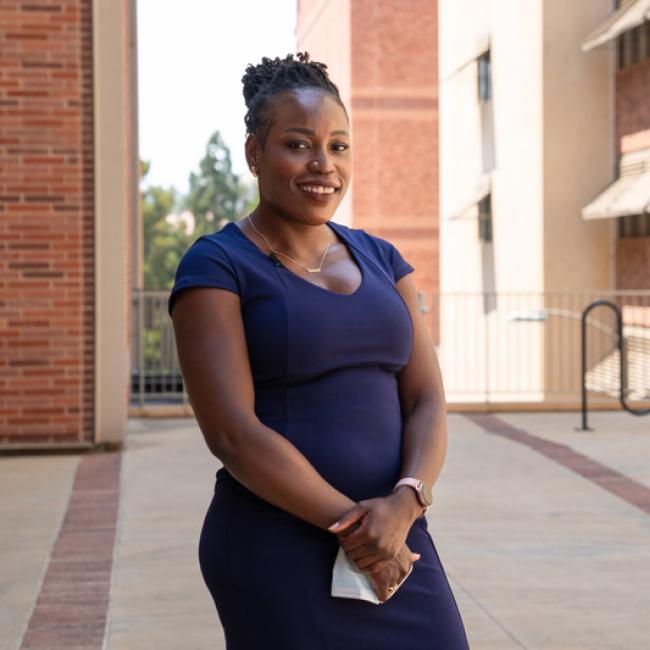
Dr. “Tayo” Ikotun Steps into the U Magazine Spotlight
As head of the Laboratory for Image Guided Immunotherapy, Oluwatayo “Tayo” Ikotun, PhD, assistant professor of molecular and medical pharmacology and a member of the Crump Institute for Molecular Imaging and the Eli and Edythe Broad Center of Regenerative Medicine and Stem Cell Research at UCLA, uses nuclear imaging to better understand how the immune system responds to the onset of disease and therapeutic interventions. She hopes that the knowledge gleaned from her studies will lead to the design of therapeutics that can be precisely tailored to address the unmet needs of the 60-to-70% of patients who remain unresponsive to current cancer immunotherapies.
WHEN DID YOU FIRST START TO THINK ABOUT SCIENCE?
My parents are immigrants, and in my house you could either be a doctor, a lawyer or an engineer. My grandfather was a physician, and I admired him and wanted to follow in his footsteps. When I went to college, I discovered I really like chemistry. Professor Robert LaDuca let me into his chemistry lab when I was an undergraduate at Kings College, and that is where I started doing actual science.
WHAT WAS YOUR FIRST EXPERIMENT?
I was a late bloomer. My first real experiments were in general chemistry labs, mixing an acid and a base together and measuring the pH, making soap, doing titrations, that sort of thing. It was pretty rudimentary, but I always enjoyed seeing the color changes — cooper going from blue to green, for example. I thought that was cool. I like colors.
WHAT HAS BEEN THE GREATEST CHALLENGE IN YOUR WORK?
Assay development. I think that’s the bane of most people working in laboratory science. It can take a lot of time, and it can be very frustrating because it’s test, change a variable, repeat, change another variable, repeat. It’s the hardest step, and it is possible while you’re trying to get it right to lose faith in the project. But once you have it, then it’s smooth sailing. Just having the patience to do all of the right steps in the right order and not be sloppy and not jumping ahead, but sitting and doing that meticulous, often-tedious repetition, can be a challenge.
WHERE DOES YOUR INSPIRATION COME FROM?
From my parents. They sacrificed a lot for us; their children are their greatest source of pride. And my aunt passed away from a rare uterine cancer, and that, too, has been a big motivator to better understand the nature of cancer and help develop tools to detect when cancers go rogue.
WHO IS YOUR SCIENCE HERO?
As a graduate student, I admired P.J. Sadler, from the University of Warwick in Great Britain. I met him in person at a conference, and he was the nicest, most approachable human being, and it showed me that you can do great science and be really smart and well-published and still be a normal and super-approachable person who creates space for trainees to talk to you. Another science hero is now a colleague, Michael Phelps, and he is a big part of the reason I came to UCLA. He has always been very approachable and made himself available. Science is hard, but we’re all still just human beings.
WHERE ARE YOU HAPPIEST?
I have good friends who are at the same level as me, or just a few years ahead, and when we get together, we talk about where the field is and what do we think about this or that and why something maybe isn’t working. Having a safe space to explore what you’re thinking, no matter how kooky, and seeing if you can convince people who are comfortable telling you that your idea is dumb because of this, or is great because of that, is really inspiring.
WHAT DO YOU CONSIDER TO BE YOUR FINEST ACHIEVEMENT?
I’m still waiting on that. I feel like I’m still a baby scientist, just starting to figure out my place in the scientific world.
WHAT IS YOUR GREATEST VIRTUE?
I think that I am empathetic. I try to understand where people are at. I think that empathy also carries over into vigilance; we have to keep the patients and their families who are looking to us to help them at the forefront of our minds when we are at the bench.
WHAT IS YOUR GREATEST FAULT?
I’m very direct, and I recognize that can be off-putting, and that maybe that can make students feel like I’m not on their side. But that is not the case at all; I am 100% committed to their learning and success. I feel clarity and directness are important for science and their training.
WHAT IS YOUR MOTTO?
“The only failure is failure to learn.” Also, one that I live by is, “If you’re not learning, then you better be dying.” That one came from my PhD advisor.
WHOM DO YOU MOST ADMIRE?
My mom. Life has thrown her so many curves, and she just gets on with it. She put that into raising us and taught us to pull ourselves up and keep it moving. Professionally, my PhD advisor at Syracuse University, Robert Doyle. He was tough on us so that we would be good scientists, but he’s always been there for us and still makes himself available — a mentor for life. Ann-Marie Chacko, a colleague at Duke-NUS Medical School in Singapore, also is someone who always inspires me. She’s like a shot of Red Bull for me.
IF NOT A SCIENTIST, WHAT WOULD YOU BE?
Maybe I would have gone into acting or stand-up comedy. I was really into performance arts when I was younger — member of the drama club, acting in school plays, being in an acting troupe. My brother thinks I should try an open-mic night. Maybe I will.
WHAT IS YOUR MOST TREASURED POSSESSION?
My dog, Milo. He is a real emotional support for me. Rough day at work? He’s right there to be a bud. Long nights in the lab? He’s up for that, too. He’s a Bernese mountain dog-poodle mix and is the sweetest dog ever.
TO WHICH SUPERHERO DO YOU MOST RELATE?
My favorite is Rogue, from the X-Men. She’s always the pinch hitter, and even though she’s not the leader, she is the strongest. I think I relate to that because in life, I’m generally the pinch hitter, the one my friends call in an emergency and things like that.
WHAT KEEPS YOU UP AT NIGHT?
Worrying that I won’t contribute anything insightful to the field, that I won’t be the mentor that my students need — not the one they want, but the one they need — and that we won’t get funding.
WHAT IS THE BEST MOMENT OF YOUR DAY?
When I see a student get it. It’s like seeing a scientist being born and is the most rewarding thing.
HOW DO YOU HOPE TO CHANGE THE WORLD?
I’d like to help deliver something that actually gets implemented in the clinical setting to benefit patients. And also, I really want to have inspired the next generation of scientists in some way, whether it’s for them to have someone who believed in them before they believed in themselves, or for them to have someone who will advocate for them and push them toward achieving their scientific dreams. Ultimately, I hope that my students will be better than I am.
WHAT IS YOUR DEFINITION OF HAPPINESS?
Being content with the things around you, having the grace to accept the things you cannot change, being lucky enough to do what you feel you were put on this earth to do and finding people who see that passion and excitement in you and who celebrate it with you and inspire you to be better.
WHAT IS YOUR DEFINITION OF MISERY?
Being extraordinarily ordinary. Not being challenged or working at my fullest potential. Misery would be just existing, getting up and not doing something that really excites me, that makes me feel vibrant or passionate or alive.
WHAT MUSIC DO YOU LISTEN TO WHILE YOU WORK?
When I was spending a lot of time in the lab, it would be ’90s hip-hop, but now that I spend more time pondering and writing, I’ve started listening to Lo-Fi beats. It’s very Zen. It’s just something in the background that keeps me moving but doesn’t distract me. But when I’m in the lab pipetting, it’s ’90s hip-hop, R&B and pop.
